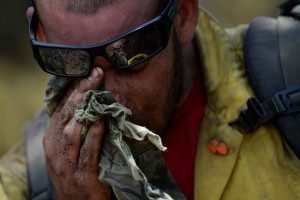 Print a Sign-In Sheet | Spanish Version
Print a Sign-In Sheet | Spanish Version
Working in a hot environment puts stress on the body’s cooling system. When heat is combined with other stresses, such as hard physical work, loss of fluids, humidity, and fatigue, it may lead to heat-related illness, disability, or even death.
Water is crucial to helping the body adjust to high temperatures. The rate of water intake must equal the increased rate of water loss by perspiration to keep body temperature normal. When it’s hot, drink plenty of water!
Heat Stress Hazards
The following are three common conditions that can result from the body overheating:
Heat cramps – Heavy sweating drains the body of salt, which cannot be replaced by simply drinking water. As a result, painful cramps may occur in the arms, legs, or stomach. If you experience cramping, move to a cool area immediately. Loosen clothing and drink cool, lightly-salted water, or a commercial fluid replacement beverage. Seek medical aid if the cramps are severe or don’t subside.
Heat exhaustion – Inadequate water and salt intake causes the body’s cooling system to break down. Symptoms include heavy sweating, moist skin, body temperature over 100.4 degrees, weak pulse, and in some cases low blood pressure. The victim is likely to be tired, weak, clumsy, upset, or confused. The individual will be very thirsty and will pant or breathe rapidly and vision may be blurred. If these symptoms are observed, get medical help immediately! Heat exhaustion can lead to heat stroke, so it is imperative that you move the person to a cool, shaded area. Loosen or remove excess clothing. Provide cool, lightly-salted water, and fan or spray the victim with cool water.
Heatstroke – A heatstroke can kill a person quickly. Once the body uses up all its water and salt, sweating ceases and the body temperature can rise quickly. Heat stroke symptoms include:
- Weakness, confusion, distress, strange behavior.
- Hot, dry, red skin.
- Rapid pulse.
- Headache or dizziness.
- Victim may pass out and have convulsions in later stages of heat stroke.
Seek medical attention immediately if heatstroke is suspected. Until help arrives, move the victim to a cool area and remove excess clothing. Immediately initiate aggressive cooling. Aggressive cooling can be achieved by targeting the head and neck, underarms, and groin with cold compresses, such as chemical cold packs, ice water-filled bags, or cold beverage containers. Also, fan and drench the individual with cool water. Offer sips of water if the victim is conscious.
Heatwave Guidelines
The following measures should help prevent the development of heat-related illnesses:
- Slow down in hot weather. Your body’s temperature regulating system faces a much greater workload when temperature and humidity are high.
- Heed early warnings of heat stress, such as headache, heavy perspiration, high pulse rate, and shallow breathing. Take a break immediately and get to a cooler location. Watch for heat stress signs among your co-workers.
- Dress for hot weather. Lightweight, light-colored clothing retains less heat than darker clothing.
- Drink plenty of water. Don’t let yourself “dry out.”
- Increase your salt intake, preferably by adding salt to your food. Consult your physician if you are on a salt-restricted diet.
- Try to acclimate to warm weather gradually. Take it easy for those first two or three hot days. Your body will have a better chance to adjust if you take it slowly.
- Get out of the heat occasionally. Physical stress increases with time in hot weather. Take breaks in a cool, shady location.
- Wear a hat and long-sleeve shirt to prevent burning, which can increase the risk of skin cancer.
DO
- Drink plenty of water.
- Take breaks in a cool, shady area.
- Watch for symptoms of heat stress, both in yourself and co-workers.
- Call 911 immediately if heat stroke is suspected.
- Responsiveness is a key factor. Once the individual loses ability to respond to questions or becomes unconscious, your level of first-aid treatment must become aggressive in nature. Aggressive treatment should be rendered immediately in an attempt to lower the body temperature quickly.
DON’T
- Ignore symptoms of heat stress.
- Try to get a suntan while working.
- Try to keep up with the rest of the crew even though you feel ill.
KEMI does not assume liability for the content of information contained herein. Safety and health remain your responsibility. This information is to be used for informational purposes only and not intended to be exhaustive or a substitute for proper training, supervision, or manufacturers’ instructions/recommendations. KEMI, by publication of this information, does not assume liability for damage or injury arising from reliance upon it. Compliance with this information is not a guarantee or warranty that you will be in conformity with any laws or regulations nor does it ensure the absolute safety of any person, place, or object, including, but not limited to, you, your occupation, employees, customers, or place of business.

